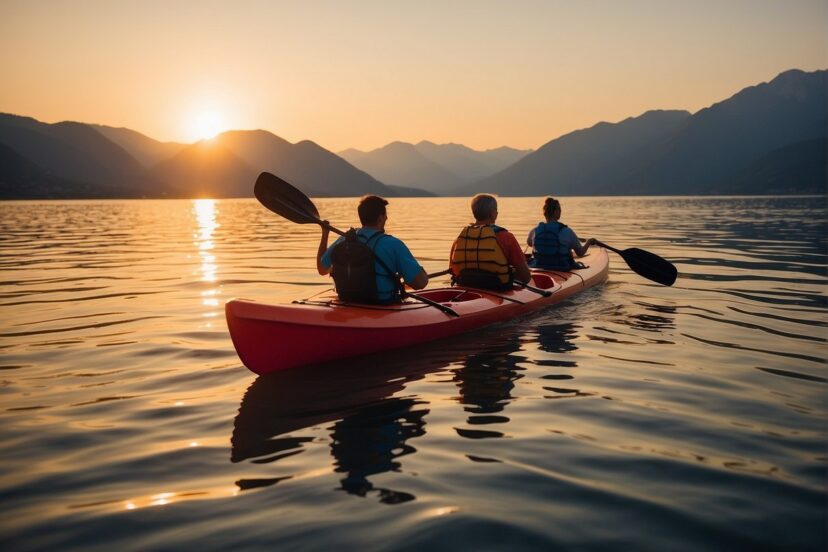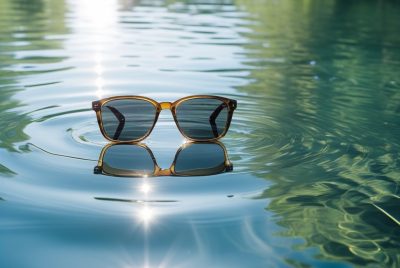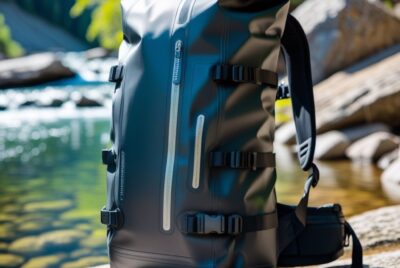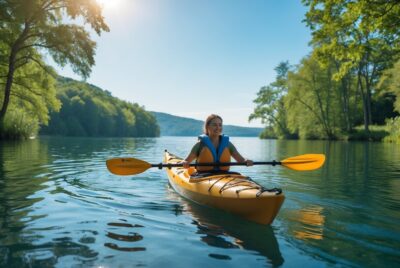3 Person Kayak Essentials: Multi-Passenger Boat
*We may earn a commission for purchases made using our links. Please see our disclosure to learn more.
3 Person Kayak Essentials: Choosing the Best Multi-Passenger Boat
Venturing out on the water with companions can enhance the paddling experience, and a 3-person kayak provides the perfect vessel for such group adventures. These kayaks are designed to accommodate three paddlers, offering an ideal balance between social interaction and coordination on the water. They are available in both inflatable and hard-shell designs, which means there’s a model suited for various preferences, whether it’s for leisurely lake explorations or more challenging river rapids.
My research on the latest models indicates a few key areas to focus on when selecting a 3-person kayak. Stability, comfort, and weight capacity are crucial considerations, as they directly impact the enjoyment and safety of the outing. Models vary widely in terms of features, from adjustable footrests and seats to storage spaces and fishing rod holders, reflecting the diverse use cases that these kayaks are equipped for. Regardless of whether the intent is to fish, tour, or simply float, there is a 3-person kayak built to meet those specific needs.
Investing time in comparing different kayak options pays off in the long run. It’s evident that each model offers distinct pros and cons, catering to the varied demands of kayakers. As someone who appreciates the nuances of kayaking in groups, I realize the importance of understanding these differences to make an informed decision. By aligning personal preferences and requirements with the right kayak features, one can ensure a rewarding and memorable group paddling experience.
Overview of 3-Person Kayaks

When selecting a 3-person kayak, I consider design, capacity, material, and adaptability to meet the varied needs of paddlers. Here, I’ll provide a detailed look at these aspects.
Types of 3-Person Kayaks
In my experience, there are primarily two types of 3-person kayaks: hard-shell and inflatable kayaks. Hard-shell kayaks, like the Sea Eagle 420x, are known for their durability and performance. They offer a rigid structure that can better handle diverse water conditions. On the other hand, inflatable kayaks such as the Sea Eagle 370 and the Sevylor Big Basin 3-Person Kayak offer unmatched portability and storage options, making them ideal for casual trips and those with limited storage space.
Size and Weight Considerations
When transporting and storing a 3-person kayak, the size and weight are crucial. Most hard-shell tandem kayaks, which can accommodate up to three paddlers, are larger and heavier; some may require a roof rack or trailer for transportation. In contrast, inflatable models like the Sea Eagle 370 typically weigh less and can be easily transported in a carry bag.
Here’s a brief comparison:
| Kayak Model | Type | Approximate Weight | Kayak Model |
| Sea Eagle 420x | Hard-shell | 42 lbs | Sea Eagle 420x |
| Sevylor Big Basin | Inflatable | 35 lbs | Sevylor Big Basin |
| Sea Eagle 370 | Inflatable | 32 lbs | Sea Eagle 370 |
Material and Durability
The choice between a hard-shell and an inflatable kayak also depends on the material’s durability. Hard-shell kayaks are usually made from polyethylene or composites, which are resistant to impact and abrasion. Inflatable kayaks, despite their perceived susceptibility, have come a long way in material technology, often employing heavy-duty PVC for puncture resistance. The Sea Eagle 420x stands out for its robust construction suitable for class IV rapids, while the Sevylor Big Basin is designed to provide a reliable and tough structure for family adventures.
Important Features of 3-Person Kayaks

When looking at 3-person kayaks, the elements that make for a satisfying paddling experience are stability, comfort, and practicality. I’ll explore how stability affects performance, why comfort and accessibility are critical, and the importance of storage and portability features.
Stability and Performance
A stable kayak is essential for a pleasant trip, especially when accommodating three paddlers. For stability, I focus on kayaks with a wide beam. This design decreases the chance of tipping and is a must for family outings or calm water exploration. When considering performance, tracking—the kayak’s ability to hold a straight line—is crucial. Kayaks with a well-designed hull and optional skegs or rudders will track more effectively, making paddling easier for all occupants.
- Stability: Wide beam for reduced tipping risk
- Tracking: Skegs or rudders improve straight-line movement
Comfort and Accessibility
Ensuring all paddlers have adjustable seats and footrests is necessary for a day out on the water. Comfort directly correlates to the time spent enjoying the journey. 3-person kayaks should feature seats that adjust to fit various body types and sizes. Kayaks with an open cockpit design allow for easier entry and exit, and, if using in cooler climates, spray skirts can be attached to prevent water from entering the kayak.
- Seats: Adjustable for personalized fit
- Cockpit: Open design for easy access, compatible with spray skirts
Storage and Portability
Storage space must be ample for gear, supplies, and sometimes a small pump in case of inflatables. Look for kayaks with dedicated storage areas, either sealed hatches or bungee-corded sections. As for portability, a 3-person kayak can be heavy, so carry handles are non-negotiable. They make transportation from vehicle to water’s edge less of a chore.
- Storage: Sealed hatches and bungee sections for gear
- Portability: Durable carry handles for easier movement
Popular 3-Person Kayak Models

My extensive experience with kayaks allows me to vouch for the popularity and reliability of a few models specifically designed for three paddlers. These kayaks have gained prominence in the market due to their build quality, features, and user satisfaction.
Sea Eagle 370 Deluxe
The Sea Eagle 370 Deluxe is a standout model thanks to its versatility and ease of handling. It’s an inflatable kayak known for its lightweight and durable construction. My experience tells me it’s well-suited for a variety of water conditions, making it a favorite among families and adventure seekers alike.
- Capacity: 3 Persons
- Weight: 32 lbs
- Load Capacity: 650 lbs
Sevylor Big Basin 3-Person Kayak
The Sevylor Big Basin is a robust option designed for stability and comfort. It’s an inflatable model that I find remarkably resilient, courtesy of its heavy-duty PVC construction. This kayak ensures a pleasant trip for three people, even when navigating rougher waters.
- Material: Heavy-duty PVC
- Design: Adjustable seats for comfort
Driftsun Rover 220
Lastly, the Driftsun Rover 220 is an inflatable kayak with a reputation for high performance. I recognize it for its impressive durability and capability to withstand the rigors of whitewater excursions. It combines an adventurous spirit with the practicality needed for family outings.
- Material: Reinforced layered PVC
- Type: Suitable for Class III and IV rapids
Choosing Your 3-Person Kayak

I understand that selecting the right 3-person kayak involves balancing purpose, budget, and maintenance while considering various personal needs. Here’s how I approach these critical factors.
Purpose and Use
My first step is to define the primary use of my kayak. When it comes to a 3-person kayak, I might be targeting recreational paddling, fishing, or using it for family outings. For recreational use, I look for stable and comfortable kayaks. If I plan on fishing, features like rod holders are significant. For family adventures, space and safety are paramount. An inflatable kayak is an excellent choice for easy transportation and storage.
Budget Considerations
I closely evaluate my budget before making a purchase. High-end kayaks with extensive features come with a steeper price, but there are quality options available that won’t break the bank. Budget-friendly kayaks may offer fewer features but can still provide a good paddling experience. Reading reviews and consulting a buying guide can help me identify the best value options within my budget range.
- Premium: High stability, durability, and extra features
- Mid-range: Good balance of features and cost
- Economy: Basic functionality, less durable materials
Maintenance and Care
Lastly, I think about the long-term maintenance and care of my kayak. Inflatable kayaks require puncture repair kits and proper drying to prevent mold. Hard-shell kayaks need UV protection and occasional repairs. For me, choosing a kayak also means committing to its upkeep to ensure safety and longevity. Regular cleaning, proper storage, and timely repairs keep my kayak in prime condition for every adventure.
Frequently Asked Questions
In this section, I cover some of the most common inquiries about three-person kayaks, including details on design choices, top models, and usage tips to help you make an informed decision.
1. What are the benefits of a hard shell versus an inflatable 3-person kayak?
Hard shell kayaks offer superior durability and performance, particularly in rough waters. They typically provide better speed and tracking due to their rigid structure. Inflatable kayaks, on the other hand, boast convenience in terms of portability and storage, and they can be more comfortable and forgiving when hitting objects in the water.
2. How does the addition of pedals enhance the experience of a 3-person kayak?
Pedals in a 3-person kayak allow for hands-free navigation and can provide a significant advantage in terms of speed and maneuverability. They’re especially useful for anglers who require free hands for fishing, and they can also make long-distance trips less tiring.
3. What factors should be considered when purchasing a 3-person kayak for fishing?
Key factors include the kayak’s stability, storage capacity, and the ability to mount accessories such as rod holders. Additionally, it’s important to look for kayaks with comfortable seating for extended periods and sufficient weight capacity to handle gear and catches.
4. Can you use a 3-person kayak solo, and what are the considerations?
Yes, you can use a 3-person kayak solo, but consider the kayak’s weight and how it affects handling and transport. The kayak’s design should permit seat repositioning for proper weight distribution and balance when paddling alone.
5. What is the typical weight capacity of a 3-person kayak?
The weight capacity for a 3-person kayak can vary, but a common range would be between 500 to 900 pounds. This is designed to accommodate three adults and their gear. For instance, the Sea Eagle 420x Explorer supports up to 855 pounds, making it suitable for multi-person use with additional gear.




